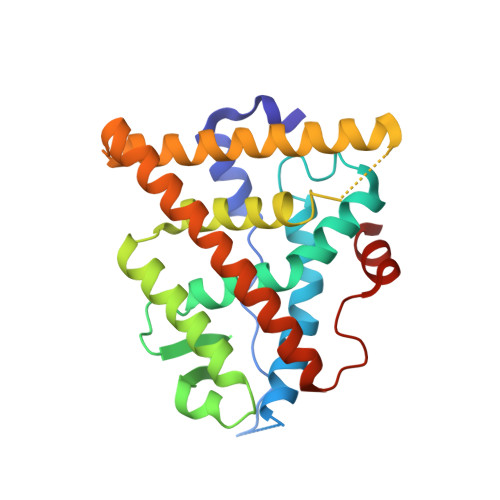The SERM/SERD bazedoxifene disrupts ESR1 helix 12 to overcome acquired hormone resistance in breast cancer cells.
Fanning, S.W., Jeselsohn, R., Dharmarajan, V., Mayne, C.G., Karimi, M., Buchwalter, G., Houtman, R., Toy, W., Fowler, C.E., Han, R., Laine, M., Carlson, K.E., Martin, T.A., Nowak, J., Nwachukwu, J.C., Hosfield, D.J., Chandarlapaty, S., Tajkhorshid, E., Nettles, K.W., Griffin, P.R., Shen, Y., Katzenellenbogen, J.A., Brown, M., Greene, G.L.(2018) Elife 7
- PubMed: 30489256
- DOI: https://doi.org/10.7554/eLife.37161
- Primary Citation of Related Structures:
4XI3 - PubMed Abstract:
Acquired resistance to endocrine therapy remains a significant clinical burden for breast cancer patients. Somatic mutations in the ESR1 (estrogen receptor alpha (ERα)) gene ligand-binding domain (LBD) represent a recognized mechanism of acquired resistance. Antiestrogens with improved efficacy versus tamoxifen might overcome the resistant phenotype in ER +breast cancers. Bazedoxifene (BZA) is a potent antiestrogen that is clinically approved for use in hormone replacement therapies. We found that BZA possesses improved inhibitory potency against the Y537S and D538G ERα mutants compared to tamoxifen and has additional inhibitory activity in combination with the CDK4/6 inhibitor palbociclib. In addition, comprehensive biophysical and structural biology studies show BZA's selective estrogen receptor degrading (SERD) properties that override the stabilizing effects of the Y537S and D538G ERα mutations.
Organizational Affiliation:
Ben May Department for Cancer Research, University of Chicago, Chicago, United States.















